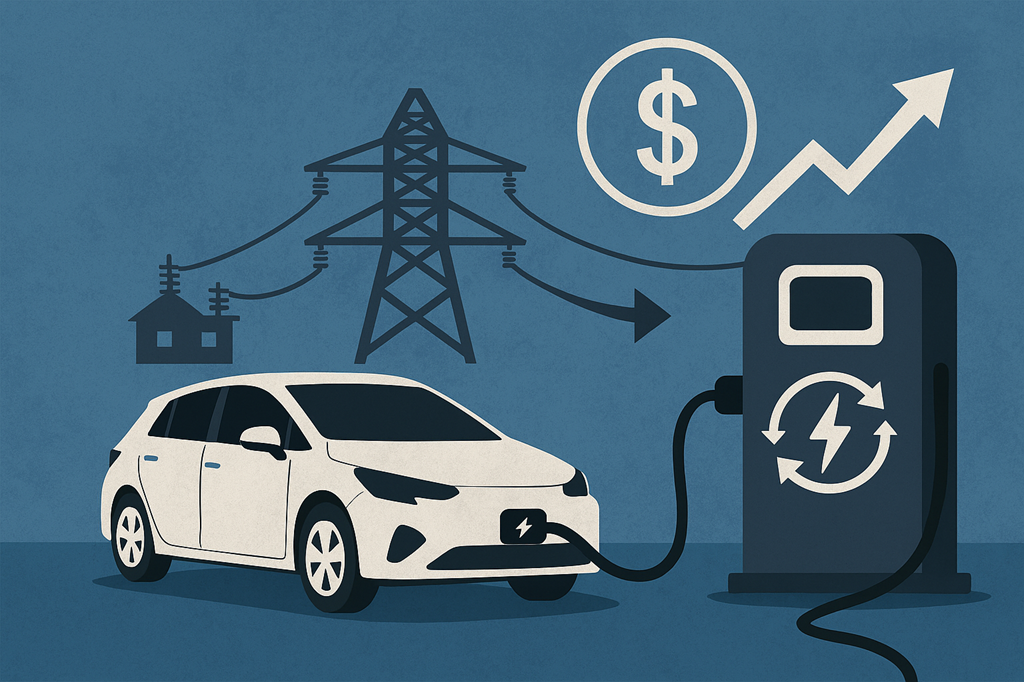
Introduction
A new report from the Union of Concerned Scientists (UCS), Harnessing the Power of EVs, delivers a compelling case for scaling vehicle-to-grid (V2G) technology in California.[i] Using detailed modeling in partnership with Evolved Energy Research, the study finds that managed EV charging can yield up to $11.7 billion per year in electricity system savings by 2045. Notably, V2G more than doubles the grid value of smart charging alone (V1G)—while requiring only limited use of EV batteries.
But beyond validating the technical and economic case, this report sends a clear message to the V2G industry: policy, vehicle capabilities, and interconnection rules must evolve now to capture this opportunity.
Here’s what the industry should take away.
1. V2G Unlocks Significant Incremental Value Beyond V1G
The modeling confirms what many in the V2G community already know: while managed charging (V1G) is valuable, bidirectional charging adds much more. In UCS’s “Medium VGI” scenario (50% of Level 2 charging enrolled in grid integration), system savings from V1G alone total $4.2 billion in 2045. Add just 25% V2G and savings rise to $7.7 billion—a nearly 60% jump. At full V2G adoption, annual savings reach $11.7 billion, or 5% of system costs.
Industry takeaway: V2G technology providers and aggregators should clearly position bidirectional charging as a cost-saving tool for the grid, not just a resiliency feature. Framing V2G as infrastructure deferral and renewable integration—rather than niche backup power—will resonate more with utilities and regulators.
2. Distribution Deferral Is the Biggest Prize
The report shows that the largest share of system savings comes from avoided investments in distribution infrastructure, not from generation or bulk storage. High V2G participation reduces peak residential and commercial demand by up to 33% and 10%, respectively—leading to significant cost avoidance in transformers, substations, and feeder upgrades.
Industry takeaway: V2G vendors should sharpen their utility business case by emphasizing local peak shaving and deferral of specific feeder upgrades. Load flexibility at the distribution edge is where V2G makes the biggest impact—and where utilities face the highest upgrade costs.
3. Battery Wear Concerns Are Overstated
In the most aggressive V2G scenario, the average vehicle discharged energy equivalent to just 700 miles of extra driving per year—less than a 7% increase in battery cycling. This conservative analysis already includes a $100/MWh degradation cost for V2G, yet still finds large net savings.
Industry takeaway: Automakers and V2G platform developers should be pushing for clear, data-backed warranty language. Battery degradation is a manageable issue—especially with smart cycling strategies. Regulators and manufacturers should recognize that V2G participation is fully compatible with long battery life.
4. The Value Per Vehicle Is Substantial
The per-vehicle savings in the UCS model range from $503/year for V1G to $1,177/year for V2G, depending on participation levels. Over a typical 12.5-year vehicle life, that amounts to $6,300 to $14,700 in grid value per EV. These are system-level savings, but they provide a strong rationale for customer-facing incentives.
Industry takeaway: V2G aggregators, DER implementers, and rate designers should use these per-vehicle numbers to justify rebates, bill credits, or performance-based compensation. These values can help structure new utility programs and customer offerings—especially in TOU, demand response, or capacity markets.
5. Scalability Hinges on Policy and Interconnection Reform
While the technical case for V2G is clear, the report emphasizes that current interconnection timelines and vehicle capabilities are not ready to scale. Very few EVs on the road today support true V2G. UCS recommends that California:
- Mandate bidirectional capability in new vehicles
- Streamline interconnection pathways for EVs
- Include V2G in utility forecasting and grid planning
- Expand participation incentives, especially for low-income drivers
- Update battery warranty protections
Industry takeaway: V2G stakeholders must actively engage in policy advocacy. Requiring bidirectional hardware and simplifying interconnection are threshold issues. Automakers, charging hardware providers, and V2G software platforms must work in tandem with state agencies to remove structural barriers.
What the Study Doesn’t Capture
While the UCS report presents a compelling case for V2G, it also has limitations that industry stakeholders should consider.
First, the analysis focuses exclusively on light-duty EVs with Level 2 charging, omitting medium- and heavy-duty vehicles that could offer even greater grid value. It also does not differentiate between behind-the-meter (non-exporting) and grid-exporting V2G, meaning some value streams—like resilience or retail bill savings—are not fully represented.
Second, the model assumes perfect system coordination and aggregate fleet behavior, which may overestimate the ease of real-world implementation. Key barriers such as communication interoperability, program participation rates, and local feeder constraints were not deeply modeled.
Lastly, the modeling assumes continued adoption of time-of-use (TOU) rates and does not explore alternative rate designs or markets that could enhance or constrain V2G performance.
For the V2G industry, this underscores the need to complement system-level modeling with real-world pilot data and customer insights to refine value estimates and program design.
The Bottom Line
The UCS study makes the case that V2G is no longer just a promising pilot concept—it is a cost-effective grid resource that can help California (and other jurisdictions) meet clean energy goals at lower cost. But realizing this value requires decisive action: equipping vehicles with V2G capability, creating viable compensation pathways, and modernizing grid interconnection.
For the V2G industry, this report is both a validation and a call to arms. The opportunity is enormous—but capturing it depends on aligning technical capabilities with policy, market rules, and customer value.
[i] See Houston, Sam, David Reichmuth, and Mark Specht. 2025. Harnessing the Power of Electric Vehicles: Integrating Light-Duty EVs with the Grid in California for a Cheaper, More Reliable, Decarbonized Electric System. Cambridge, MA: Union of Concerned Scientists. https://doi.org/10.47923/2025.15888.